OK, first an update on our special “questing beasts”: last weekend after Roberta Ayres, our education officer, finally arrived, we had a traditional Sao Tome dinner at Nova Moca, a former plantation high on the eastern slopes of the mountain. This is where Ricardo Lima lives, our graduate student colleague who first brought my attention to the supposedly endemic Sao Tome shrew and our mystery “charroco,” the fish that does not appear on our fish checklist.
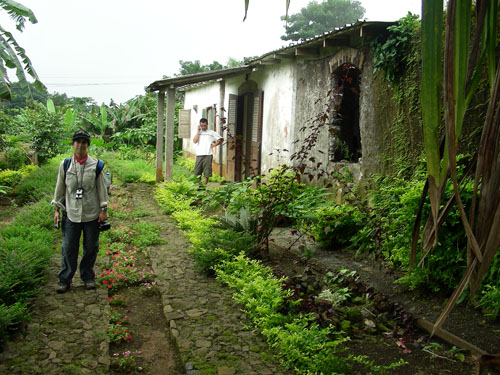
Roberta Ayers at Nova Moca (Ricardo Lima in back). RCD phot. GG IV
Ricardo gave me the preserved shrew he had already caught, a piece of its tail preserved separately, and the tail of a second shrew, removed by machete by one of Ricardo’s assistants (I should add that shrews are mean critters to handle, and some species have a toxic bite)… the rest of the shrew escaped. Again, we are anxious to test the DNA of this species to see if it is in fact a real endemic or was brought to the islands recently (like during the last 500 years of Portuguese comings and goings). We are unsure of what preservative Ricardo used for the material (he doesn’t remember), so we will be uncertain as to the value of what we already have until we get back to the lab. But I have left a couple of liters of 85% with him, so we know we will get DNA from the next shrew that is encountered
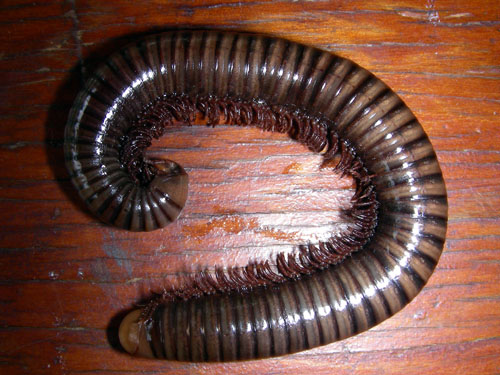
Millipede from Bom Sucesso. RCD phot. GG IV
Another questing beast is the millipede. To our knowledge, this group (the myriapods) has not been sampled on the islands, and our colleague at North Carolina State Museum, Dr. Rowland Shelley (a specialist on the group) expressed doubt that there was much present. Sure enough, almost the first log we turned over had a bunch of them underneath, and we also have a sample from 1100 m higher (including the above). Obviously we will search many more localities, both here and on Principe. I must also add that it is wonderful to have an expert colleague willing to examine stuff like this and give us some answers… the Academy has a lot of experts, but we don’t do everything.
The botany guys, Tom and Jim are doing wondrous things:
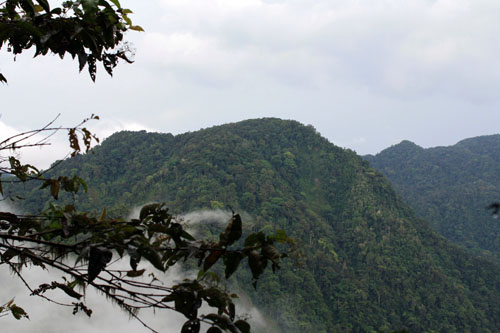
Pico Cavalio from the north. T. Daniel phot.GG IV
The picture above is of Pico Cavalio, one that must be climbed en route to the ultimate Pico de Sao Tome at 2,000 meters. This one is a brute and our guys have collected the top of it. So far, this is the highest locality that any of our expedition members has ever reached at 1566m. Also, the guys have found a bunch of new trails through really good forest that earlier teams missed, especially around Lagoa Amelia (in earlier blogs)-- some of the results have been pretty spectacular.
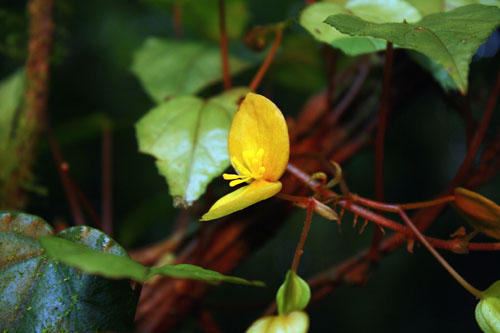 Begonia macambrarensis, A Sao Tome endemic. T. Daniel phot. GG IV
Begonia macambrarensis, A Sao Tome endemic. T. Daniel phot. GG IV
This yellow begonia is known only from Sao Tome, and Tom and Jim found it on the way up to Pico Cavalio. This is our first collection of this endemic and quite exciting.

Brachystephanus occidentalis 2 more to go! T. Daniel phot.GG IV
Although the begonia is exquisite, Tom got even more excited about the critter above. Tom just published a monograph of the Acanthaceae of Sao Tome and Principe. By the end of GG III, he had found all but three of the endemic species present on the islands – now the list is down to two! And we have tissue samples for comparison with members oft his family on the mainland and other parts of the world.
Jim Shevock is in “seventh heaven;” he is up to 400 collections. Many of you don’t know Jim yet (he is new to the CAS faculty)—Jim is not only tireless, but totally ebullient! Nothing bothers him (and Tom and I have been trying!)

Jim Shevock collecting new trail. T. Daniel phot.GG IV
One of the real pleasures of leading these expeditions is learning how differently we do the same thing—collecting and preparing specimens. Collecting for Jim just looks like scraping away at rocks, or tree trunks and other substrates (of course, you have to know where to look, and that can take many years). And basically that is what he is doing.. However, the way he prepares his collections is really different.
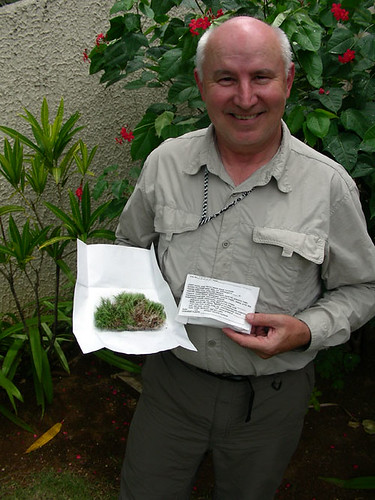 Jim with prepared specimens of Leucobryum RCD phot. GG IV
Jim with prepared specimens of Leucobryum RCD phot. GG IV
Jim does not press plants like Tom does—the stuff Jim collects is already pretty flat! Instead, he has special archival paper which has, already printed on each sheet, a table that includes blanks for the number of the specimen as well as for the whole range of possible environmental conditions under which the specimen was collected. He fills out the blanks (duplicates everything on the computer, of course), then folds the specimen into the paper in such a way that each packet stands up while the specimen is drying within. Our room (all 3 of us together) frequently looks like a major regatta on San Francisco Bay.
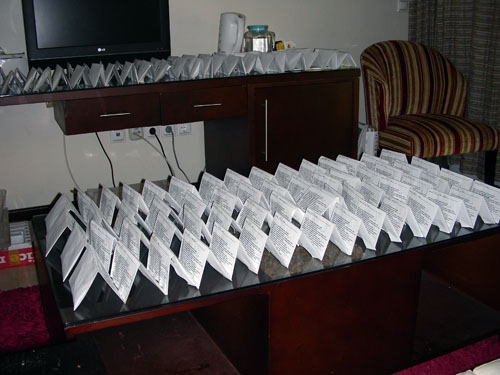
Regatta in room #10. RCD phot. GG IV
It is probably obvious to anyone reading this that we could not do any of this work without approval from the authorities, especially the Ministry of the Environment. The Director is Arlindo Carvalho, a delightful man. One of the other gentlemen with whom we work is Vitor Bonfim, who is head of Conservation on the islands. I am including a picture of Vitor because his nephew is a FaceBook friend of mine.. a student in Los Angeles!
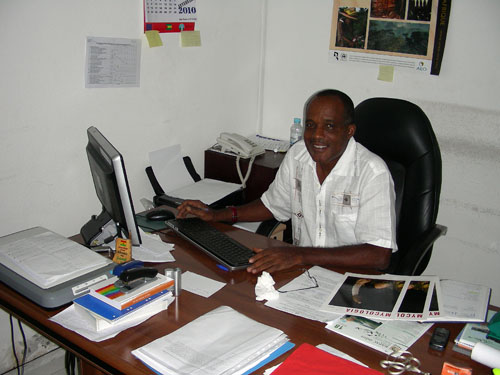
While the guys are having all this fun, Roberta Ayers and I have been pursuing the education proposal/dream/idea. We have had an amazing series of meetings with all sorts of people here on the islands; it is my intention that whatever we come up with will have the enthusiasm of the citizens at all levels.
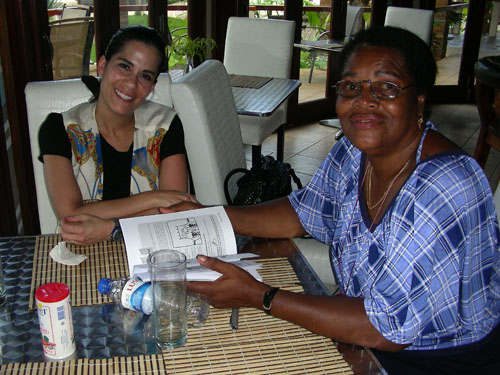
Roberta Ayres and Roberta dos Santos. Omali Lodge. RCD phot GG
A very dear old friend of mine is Roberta dos Santos. Roberta works with Ned Seligman in his NGO, STeP UP. In fact, Ned met Roberta when he was running the Peace Corps here, years ago. But more than that, she has been in education her entire life and her degree (in education) is from the US. (Imagine a young girl born and raised on Sao Tome—on the Equator—landing in Buffalo, New York in mid January!) We have contracted with Roberta to assist our CAS Roberta set up meetings, etc. And Roberta knows absolutely everybody. The “Dos Robertas” are a wonderful team. Our CAS Roberta has the perfect personality as well as the educational know-how for what we are trying to accomplish, and I am much impressed. She “gets it,” and is fun.
After some panicky moments yesterday, our flights to Principe, the much older, smaller island, have been confirmed. I must confess I will be glad to get back out into the field. While I do have this dream for raising awareness of the unique biodiversity here, I really am a bush guy at heart, and meetings pale in comparison to stomping around in forests and swamps. CAS Roberta has all she needs to carry on during the week we are gone and is totally comfortable. Tom, Jim and I take off on Sunday and will return a week later, after Roberta has flown home. With fingers crossed, we are off to see if “cobra bobo” exists on Principe.
The Parting Shot:
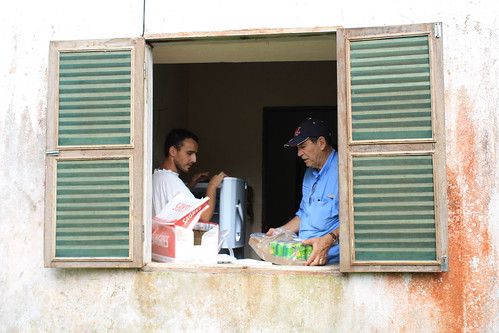
Dinner at Nova Moc. Ricardo Lima and RCD. T. Daniel phot. GG IV
PARTNERS
We gratefully acknowledge the support of the G. Lindsay Field Research Fund, Hagey Research Venture Fund of the California Academy of Sciences, the Société de Conservation et Développement (SCD) and Africa’s Eden for logistics, ground transportation and lodging, STePUP of Sao Tome http://www.stepup.st/, Arlindo de Ceita Carvalho, Director General, and Victor Bomfim, Salvador Sousa Pontes and Danilo Barbero of the Ministry of Environment, Republic of São Tomé and Príncipe for permission to export specimens for study, the continued support of Bastien Loloumb of Monte Pico and Faustino Oliviera, Director of the botanical garden at Bom Sucesso. Special thanks for the generosity of private individuals, George G. Breed, Gerry F. Ohrstrom, Timothy M. Muller, Mrs. W. H. V. Brooke, Mr. and Mrs. Michael Murakami, Hon. Richard C. Livermore, Prof. & Mrs. Evan C. Evans III and Mr. and Mrs. Robert M. Taylor for helping make these expeditions possible. Our work can be supported by donations to CAS, Gulf of Guinea Fund